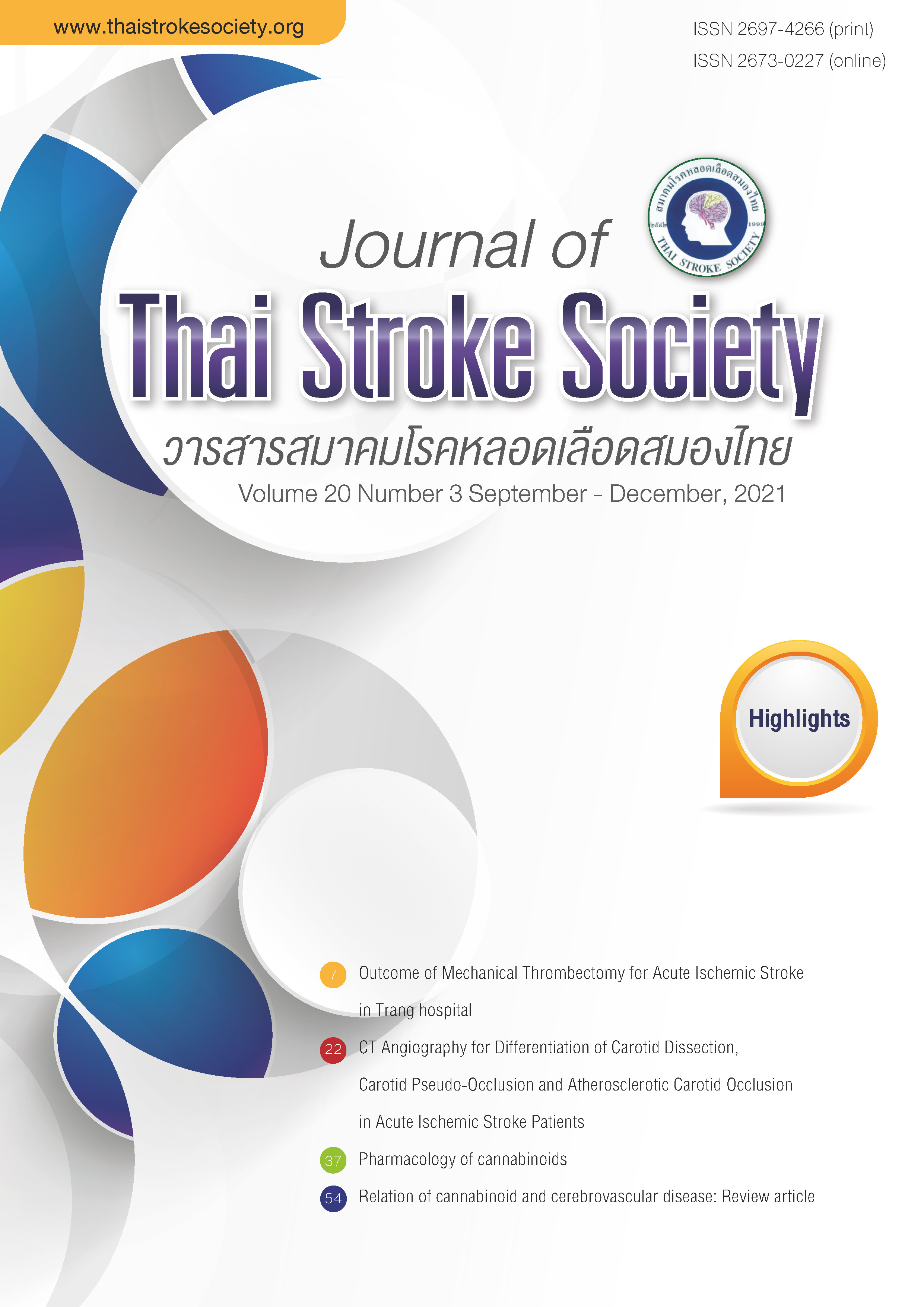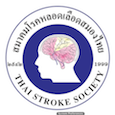Relation of cannabinoid and cerebrovascular disease: Review article
Keywords:
cannabinoids, incidence of stroke, mechanism of cannabinoid related stroke, efficacy of cannabinoidAbstract
Until present, cannabinoid from either phytocannabinoid or synthetic cannabinoid were under investigated in various medical conditions in clinical trials. Cannabinoid which had been using and was approved to use in neurological disease such as for treatment resistance epilepsy, spasticity in multiple sclerosis, and chemotherapy induced nausea and vomiting. Apart from being used for medical condition, cannabinoid and cannabis were used as drug abused or for other recreational medicine. The number of case reports and case-series in patient presented with symptom of adverse event from cannabis and medical cannabinoid was
increased. Common disease which report concurrent with cannabis use was cerebrovascular event. Wolf, et al report the event of ischemic stroke and transient ischemic attack which were related to cannabis user. Most patient were categorized as young population who had no underlying disease or any other stroke related risk factors. By binding to the cannabinoid receptor 1, cannabinoid increased heart rate, increased blood pressure, activativated platelet function, activativated platelet aggregation, inducing the vasospasm of cerebral blood vessel and consequently lead to stroke. Additionally, there were publications that used cannabinoid as a neuroprotective agent to prevent neuronal death and prolongation of cell death from
ischemia but all of these publications were study in vitro and in animal study.
References
Archie SR, Cucullo L. Harmful Effects of Smoking Cannabis: A Cerebrovascular and Neurological Perspective. Front Pharmacol. 2019; 10:1-19.
Aronow WS, Cassidy J. Effect of Marihuana and Placebo-Marihuana Smoking on Angina Pectoris. N Engl J Med. 1974; 291:65–7.
Barnes D, Palace J, O’Brien MD. Stroke Following Marijuana Smoking. Stroke. 1992; 23:1381.
Brantl SA, Khandoga AL, Siess W. Mechanism of platelet activation induced by endocannabinoids in blood and plasma. Platelets. 2014; 25:151-61.
Caldicotta D, Holmesa J, Roberts-Thomsonb KC, Mahar L. Keep off the grass: marijuana use and acute cardiovascular events. Eur J Emerg Med. 2005; 12:236–44.
Ceprian M, Jimenez-Sanchez L, Vargas C, Barata L, Hind W, Martinez-Orgado J. Cannabidiol reduces brain damage and improves functional recovery in a neonatal rat model of arterial ischemic stroke. Neuropharmacology. 2017; 116:151-9.
Ducros A. Reversible cerebral vasoconstriction syndrome. Lancet Neurol. 2012; 11(10):906-17.
Galli JA, Sawaya RA, Friedenberg FK. Cannabinoid Hyperemesis Syndrome. Curr Drug Abuse Rev. 2011; 4:241–9.
Goyal H, Awad HH, Ghali JK. Role of cannabis in cardiovascular disorders. J Thorac Dis. 2017; 9:2079-92.
Gülck T, Møller BL. Phytocannabinoids: Origins and Biosynthesis. Trends Plant Sci. 2020; 25:985-1004.
Hall W, Solowij N. Adverse effects of cannabis. The Lancet. 1998;352:1611-6.
Hemachandra D, McKetin R, Cherbuin N, Anstey KJ. Heavy cannabis users at elevated risk of stroke: evidence from a general population survey. Aust N Z J Public Health. 2016; 40:226-30.
Hiley CR, Ford WR. Cannabinoid pharmacology in the cardiovascular system: potential protective mechanisms through lipid signalling. Biol Rev Camb Philos Soc. 2004; 79:187-205.
Kanato M. Impacts of Medical Cannabis Law in Thailand. ONCB Journal. 2020; 36:27-36.
Kosior DA, Filipiak KJ, Stolarz P, Opolski G. Paroxysmal atrial fibrillation in a young female patient following marijuana intoxication – a case report of possible association. Med Sci Monit. 2000; 6:386-9.
Mateo I, Pinedo A, Gomez-Beldarrain M, Basterretxea JM, Garcia-Monco JC. Recurrent stroke associated with cannabis use. J Neurol Neurosurg Psychiatry. 2005; 76:435-7.
Mittleman MA, Lewis RA, Maclure M, Sherwood JB, Muller JE. Triggering Myocardial Infarction by Marijuana. Circulation. 2001; 103:2805-9.
Olah T, Bodnar D, Toth A, Vincze J, Fodor J, Reischl B, et al. Cannabinoid signalling inhibits sarcoplasmic Ca2+ release and regulates excitation–contraction coupling in mammalian skeletal muscle. J Physiol. 2016; 594:7381–98.
Pacher P, Batkai S, Kunos G. The Endocannabinoid System as an Emerging Target of Pharmacotherapy. Pharmacol Rev. 2006; 58:389–462.
Parekh T, Pemmasani S, Desai R. Marijuana Use Among Young Adults (18-44 Years of Age) and Risk of Stroke: A Behavioral Risk Factor Surveillance System Survey Analysis. Stroke. 2020; 51:308-10.
Stella N. Cannabinoid and cannabinoid-like receptors in microglia, astrocytes, and astrocytomas. Glia. 2010; 58:1017-30.
Wang R, Tu S, Zhang J, Shao A. Roles of TRP channels in neurological diseases. Oxid Med Cell Longev. 2020; 2020:1-13.
Westover AN, McBride S, Haley RW. Stroke in Young Adults Who Abuse Amphetamines or Cocaine A Population-Based Study of Hospitalized Patients. Arch Gen Psychiatry. 2007; 64:495-502.
Whiting PF, Wolff RF, Deshpande S, Di Nisio M, Duffy S, Hernandez AV, et al. Cannabinoids for Medical Use: A Systematic Review and Meta-analysis. JAMA. 2015; 313:2456-73.
Wolff V, Armspach JP, Lauer V, Rouyer O, Bataillard M, Marescaux C, et al. Cannabis-related stroke: myth or reality? Stroke. 2013; 44:558-63.
Wolff V, Lauer V, Rouyer O, Sellal F, Meyer N, Raul JS, et al. Cannabis use, ischemic stroke, and multifocal intracranial vasoconstriction: a prospective study in 48 consecutive young patients. Stroke. 2011; 42:1778-80.
World Drug Report 2020 [Internet]. United Nations publication. 2020 [cited 25 Dec 2020]. Available from: www.unodc.org/wdr2020.
World Health Organization. The health and social effects of nonmedical cannabis use [Internet]. the WHO Document Production Services. 2016 [cited 25 Dec 2020]. Available from: https://www.who.int/substance_abuse/
publications /msb_cannabis_report.pdf. 29. Zachariah SB. Stroke After Heavy Marijuana Smoking. Stroke. 1991; 22:406-9.
Bisogno T, Hanus L, Petrocellis LD, Tchilibon S, Ponde DE, Brandi I, et al. Molecular targets for cannabidiol and its synthetic analogues: effect on vanilloid VR1 receptors and on the cellular uptake and enzymatic hydrolysis of anandamide. Br J Pharmacol. 2001;134:845-52.
Choi S, Mou Y, Silva A. Cannabis and cannabinoid biology in stroke controversies, risks, and promise. Stroke. 2019 50:2640-5.
Devinsky O, Patel AD, Cross JH, Villanueva V, Wirrell EC, Privitera M, et al. Effect of Cannabidiol on Drop Seizures in the Lennox-Gastaut Syndrome. N Engl J Med. 2018;378:1888-97.
Devinsky O, Cross JH, Laux L, Marsh E, Miller I, Nabbout R, et al. Trial of Cannabidiol for Drug-Resistant Seizures in the Dravet Syndrome. New England Journal of Medicine. 2017;376:2011-20.
Collin C, Davies P, Mutiboko IK, Ratcliffe S. Randomized controlled trial of cannabis-based medicine in spasticity caused by multiple sclerosis. Eur J Neurol. 2007;14:290-6.
Marinelli L, Balestrino M, Mori L, Puce L, Rosa GM, Giorello L, et al. A randomised controlled cross-over double-blind pilot study protocol on THC:CBD oromucosal spray efficacy as an add-on therapy for poststroke spasticity. BMJ Open. 2017;7:e016843.
Maas A, Murray G, Henney H, Kassem N, Legrand V, Mangelus M, et al. Efficacy and safety of dexanabinol in severe traumatic brain injury: results of a phase III randomised, placebo-controlled, clinical trial. Lancet Neurol. 2006;5:38-45.
Downloads
Published
How to Cite
Issue
Section
License
ข้อความภายในบทความที่ตีพิมพ์ในวารสารสมาคมโรคหลอดเลือดสมองไทยเล่มนี้ ตลอดจนความรับผิดชอบด้านเนื้อหาและการตรวจร่างบทความเป็นของผู้นิพนธ์ ไม่เกี่ยวข้องกับกองบรรณาธิการแต่อย่างใด การนำเนื้อหา ข้อความหรือข้อคิดเห็นของบทความไปเผยแพร่ ต้องได้รับอนุญาตจากกองบรรณาธิการอย่างเป็นลายลักษณ์อักษร ผลงานที่ได้รับการตีพิมพ์ในวารสารเล่มนี้ถือเป็นลิขสิทธิ์ของวารสาร





